#ornithopoda
Text

Hadrosaurs at night.
#paleoart#art#dinosaur#prehistoric#paleontology#digitalart#traditionalart#hadrosaur#Ornithopoda#Ornithischia#paleoblr#digital art
337 notes
·
View notes
Text
Crystal Palace Field Trip Part 2: Walking With Victorian Dinosaurs
[Previously: the Permian and the Triassic]
The next part of the Crystal Palace Dinosaur trail depicts the Jurassic and Cretaceous periods. Most of the featured animals here are actually marine reptiles, but a few dinosaur species do make an appearance towards the end of this section.

Although there are supposed to be three Jurassic ichthyosaur statues here, only the big Temnodontosaurus platyodon could really be seen at the time of my visit. The two smaller Ichthyosaurus communis and Leptonectes tenuirostris were almost entirely hidden by the dense plant growth on the island.

Ichthyosaurs when fully visible vs currently obscured
Left side image by Nick Richards (CC BY SA 2.0)
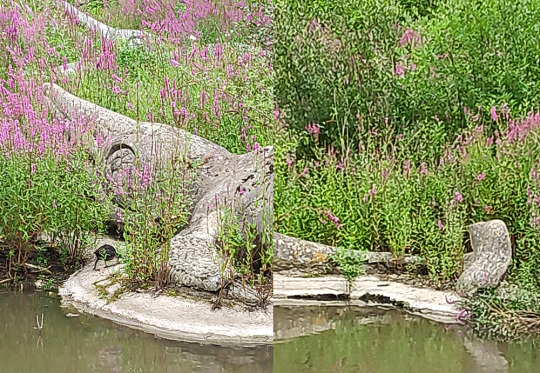
Head, flipper, and tail details of the Temnodontosaurus. A second ichthyosaur is just barely visible in the background.
Ichthyosaurs were already known from some very complete and well-preserved fossils in the 1850s, so a lot of the anatomy here still holds up fairly well even 170 years later. They even have an attempt at a tail fin despite no impressions of such a structure having been discovered yet! Some details are still noticeably wrong compared to modern knowledge, though, such as the unusual amount of shrinkwrapping on the sclerotic rings of the eyes and the bones of the flippers.

———

Arranged around the ichthyosaur, three different Jurassic plesiosaurs are also represented – “Plesiosaurus” macrocephalus with the especially sinuous neck on the left, Plesiosaurus dolichodeirus in the middle, and Thalassiodracon hawkinsi on the right.
They're all depicted here as amphibious and rather seal-like, hauling out onto the shore in the same manner as the ichthyosaurs. While good efforts for the time, we now know these animals were actually fully aquatic, that they had a lot more soft tissue bulking out their bodies, and that their necks were much less flexible.

———
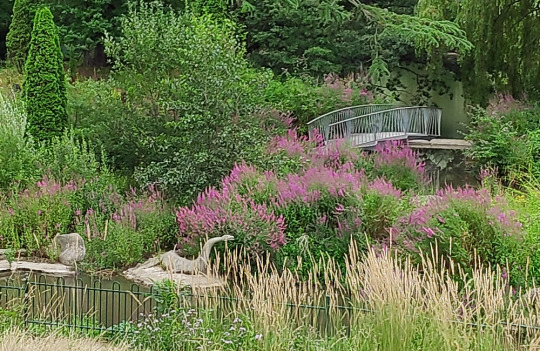
The recently-installed new pivot bridge is also visible here behind some of the marine reptiles.
———

Positioned to the left of the other marine reptiles, this partly-obscured pair of croc-like animals are teleosaurs (Teleosaurus cadomensis), a group of Jurassic semi-aquatic marine crocodylomorphs.

A better view of the two teleosaurs by MrsEllacott (CC BY-SA 4.0)
The Crystal Palace statues have the general proportions right, with long thin gharial-like snouts and fairly small limbs. But some things like the shape of the back of the head and the pattern of armored scutes are wrong, which is odd considering that those details were already well-known in the 1850s.

———
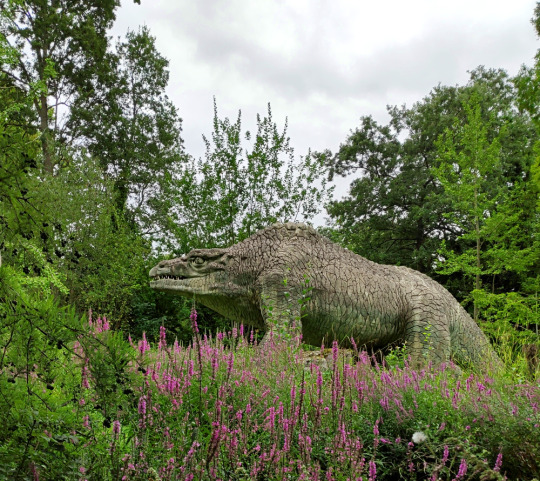
Finally we reach the first actual dinosaur, and one of the most iconic statues in the park: the Jurassic Megalosaurus!
Megalosaurus bucklandi was the very first non-avian dinosaur known to science, discovered in the 1820s almost twenty years before the term "dinosaur" was even coined.
At a time when only fragments of the full skeleton were known, and before any evidence of bipedalism had been found, the Crystal Palace rendition of Megalosaurus is a bulky quadrupedal reptile with a humped back and upright bear-like limbs. It's a surprisingly progressive interpretation for the period, giving the impression of an active mammal-like predator.
This statue suffered extensive damage to its snout in 2020, which was repaired a year later with a fiberglass "prosthesis".

———
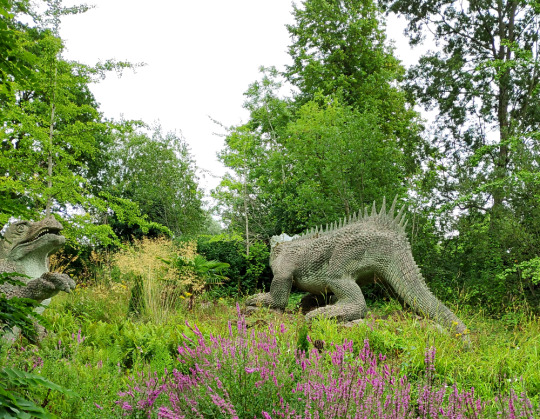
Reaching the Cretaceous period now, we find Hylaeosaurus (and one of the upcoming Iguanodon peeking in from the side).
Hylaeosaurus armatus was the first known ankylosaur, although much like the other dinosaurs here its life appearance was very poorly understood in the early days of paleontology. Considering how weird ankylosaurs would later turn out to be, the Crystal Palace depiction is a pretty good guess, showing a large heavy iguana-like quadruped with hoof-like claws and armored spiky scaly skin.
It's positioned facing away from viewers, so its face isn't very visible – but due to the head needing to be replaced with a fiberglass replica some years ago, the original can now be seen (and touched!) up close near the start of the trail.


———

Two pterosaurs (or "pterodactyles" according to the park signs) were also supposed to be just beyond the Hylaeosaurus, but plant growth had completely blocked any view of them.
Although these two statues are supposed to represent a Cretaceous species now known as Cimoliopterus cuvieri, they were probably actually modeled based on the much better known Jurassic-aged Pterodactylus antiquus.
A second set of pterosaur sculptures once stood near the teleosaurs, also based on Pterodactylus but supposed to represent a Jurassic species now known as Dolicorhamphus bucklandii. These statues went missing in the 1930s, and were eventually replaced with new fiberglass replicas in the early 2000s… only to be destroyed by vandalism just a few years later.
(The surviving pair near the Hylaeosaurus are apparently in a bit of disrepair these days, too, with the right one currently missing most of its jaws.)

Image by Ben Sutherland (CC BY 2.0)
The Crystal Palace pterosaurs weren't especially accurate even for the time, with heads much too small, swan-like necks, and bird-like wings that don't attach the membranes to the hindlimbs. Hair-like fuzz had been observed in pterosaur fossils in the 1830s, but these depictions are covered in large overlapping diamond-shaped scales due to Richard Owen's opinion that they should be scaly because they were reptiles.
But some details still hold up – the individual with folded wings is in a quadrupedal pose quite similar to modern interpretations, and the bird-like features give an overall impression of something more active and alert than the later barely-able-to-fly sluggish reptilian pterosaur depictions that would become common by the mid-20th century.

(Much like the statues themselves, the "modern" reconstruction above is based on Pterodactylus rather than Cimoliopterus)
———

The last actual dinosaurs on this dinosaur trail are the two Cretaceous Iguanodon sculptures. At the time of my visit they weren't easy to make out behind the overgrown trees, and only the back end of the standing individual was clearly visible.

Named only a year after Megalosaurus, Iguanodon was the second dinosaur ever discovered, and early reconstructions depicted it as a giant iguana-like lizard.
The Crystal Palace statues depict large bulky animals, one in an upright mammal-like stance and another reclining with one hand raised up. (This hand is usually resting on a cycad trunk, but that element appeared to be either missing or fallen over when I was there.)
Famously a New Year's dinner party was held in the body of the standing Iguanodon during its construction, although the accounts of how many people could actually fit inside it at once are probably slightly exaggerated.
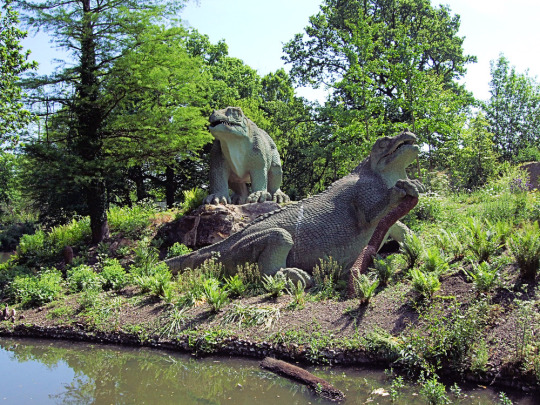
A clearer view by Jim Linwood (CC BY 2.0)
Considering that the skull of Iguanodon wasn't actually known at the time of these sculpture's creation, the head shape with a beak at the front of the jaws is actually an excellent guess. The only major issue was the nose horn, which was an understandable mistake when something as strange as a giant thumb spike had never been seen in any known animal before.

(The fossils the Crystal Palace statues are based on are actually now classified as Mantellisaurus atherfieldensis, but the "modern" reconstruction above depicts the chunkier Iguanodon bernissartensis.)
———
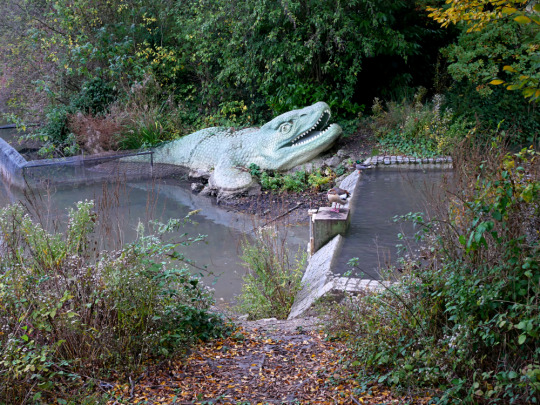
Image by Doyle of London (CC BY-SA 4.0)
I also wasn't able to spot the Cretaceous mosasaur on the other side of the island due to heavy foliage obscuring the view.
Depicting Mosasaurus hoffmannii, this model consists of only the front half of the animal lurking at the water's edge. It's unclear whether this partial reconstruction is due to uncertainty about the full appearance, or just a result of money and time running out during its creation.
The head is boxier than modern depictions, and the scales are too large, but the monitor-lizard like features and paddle-shaped flippers are still pretty close to our current understanding of these marine reptiles. It even apparently has the correct palatal teeth!

Next time: the final Cenozoic section!
#field trip!#crystal palace dinosaurs#retrosaurs#i love them your honor#crystal palace park#crystal palace#ichthyosaur#plesiosaur#teleosaurus#crocodylomorpha#marine reptile#megalosaurus#theropod#hylaeosaurus#ankylosaur#iguanodon#ornithopoda#ornithischia#dinosaur#pterodactyle#pterodactylus#pterosaur#mosasaurus#mosasaur#paleontology#vintage paleoart#art
446 notes
·
View notes
Text
Chakisaurus nekul Nogueira et al., 2024 (new genus and species)

(Tail vertebrae of Chakisaurus nekul [scale bar = 3 cm], from Nogueira et al., 2024)
Meaning of name: Chakisaurus = elder guanaco [in Tehuelche] lizard [in Greek]; nekul = swift [in Mapudungun]
Age: Late Cretaceous (Cenomanian–Turonian)
Where found: Huincul Formation, Río Negro, Argentina
How much is known: Partial skeletons of several individuals together representing much of the vertebral column and multiple limb bones. An isolated partial ulna (forearm bone) and a neck vertebra are also known.
Notes: Chakisaurus was an ornithopod, a group of plant-eating dinosaurs that includes the duck-billed hadrosaurids. However, it was only distantly related to the hadrosaurids, instead being a member of Elasmaria, a diverse group of small to medium-sized ornithopods from the Southern Hemisphere.
Chakisaurus had unusual features of its tail vertebrae indicating that the base of its tail may have been typically held with a downward curve, instead of horizontally as is the norm for most other dinosaurs. Among dinosaurs, this type of tail configuration had previously only been reported in some types of titanosaurian sauropods. Additionally, the main muscles that pull the hindlimbs backward (which are attached to the tail in most dinosaurs and other reptiles) appear to have been very well developed in Chakisaurus, which may suggest that it was a powerful sprinter.
Fossils of both juvenile and older individuals of Chakisaurus have been found, allowing study of its growth. Based on microscopic examination of its bone structure, the largest known specimen of Chakisaurus had reached sexual maturity when it died, but had not finished growing, a pattern commonly seen in Mesozoic dinosaurs.
Reference: Nogueira, R.A., S. Rozadilla, F.L. Agnolín, J.A.G. Marsà, M.J. Motta, and F.E. Novas. 2024. A new ornithopod from the Upper Cretaceous (Huincul Formation) of northwestern Patagonia, Argentina. Implications on elasmarian postcranial anatomy. Cretaceous Research advance online publication. doi: 10.1016/j.cretres.2024.105874
72 notes
·
View notes
Text
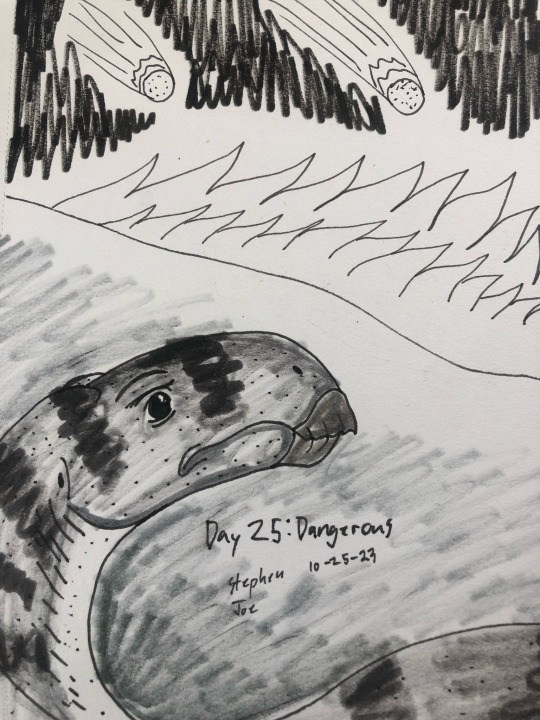
Day 25: Dangerous
A basal styracosterna Calvarius rapidus on the dangerously inferno where the meter showers fell from the sky.
#my art#dinosaur#paleoart#myart#dinosaurs#dinosauria#my drawings#inktober#ink drawing#ornithopoda#iguanodontia#styracosterna#artists on tumblr
26 notes
·
View notes
Text
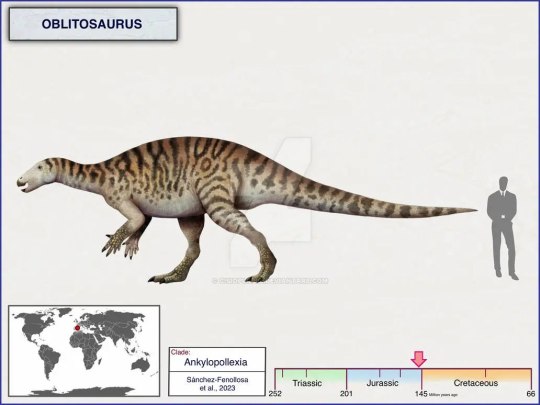
Oblitosaurus
Oblitosaurus — рід анкілоплексисових орнітоподових динозаврів з пізньоюрської формації Вільяр-дель-Арзобіспо в Іспанії. Типовий вид — Oblitosaurus bunnueli.
Повний текст на сайті "Вимерлий світ":
https://extinctworld.in.ua/oblitosaurus/
#oblitosaurus#dinosaur#jurassic#late jurassic#jurassic period#spain#dinosaurs#ornithopoda#paleontology#paleoart#prehistoric#animals#extinct#fossils#digital art#sciart#palaeoblr#article#палеоарт#палеонтологія#ukraine#ukrainian#україна#мова#українська мова#ua#тварини#арт#динозавр
22 notes
·
View notes
Text
Gasparinisaura cincosaltensis, which most people probably only know as that one dinosaur that drowned in a sauropod footprint in Planet Dinosaur.

With Hatsune Miku for scale:
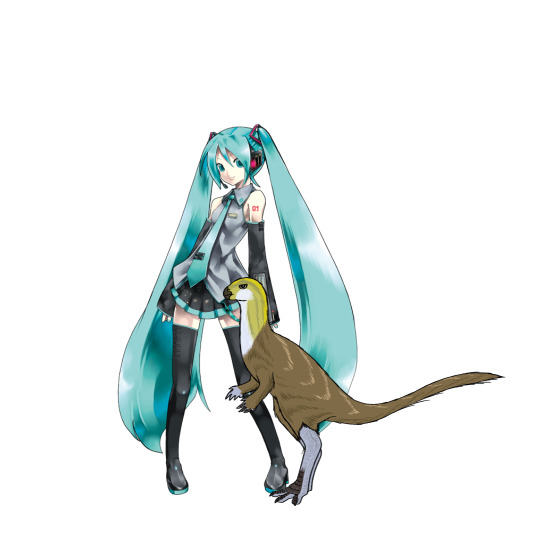
11 notes
·
View notes
Text
Dinofact #39
Dryosaurus, a small ornithopod dinosaur, was named using the Greek words 'drys' meaning tree or oak, and sauros, meaning lizard. This makes the dinosaurs name mean 'tree lizard'. Although some believe that this name is because of the vague oak-leaf shape of its cheek teeth, the name is actually in reference to its forested habitat and a presumed arboreal lifestyle. However, there is no evidence to the former, and the dinosaur has since been proben to be ground-dwelling.
Source: wikipedia
#dinosaur#dinosaurs#paleontology#dryosaurus#ornithopod#ornithopods#ornithopoda#ornithischia#herbivore#herbivorous#herbivorous dinosaur#herbivorous dinosaurs#oak#oak leaf#oak tree#fun facts#trivia#dinosaur trivia#dinosaur fun facts#2nd#october#2022#october 2nd#october 2022#october 2nd 2022
22 notes
·
View notes
Text
kimmi gamer
Hot amateur teen fucked
Solo huge tits trans masturbates
Wife ass anal culo latina amateur
Milf stepmom gives her son a nice ride in bed
Freak Teen Twerk Periscope
Gisela paraguay
Blind folded teen jizzy
r2c restauration collective casino
Filipina wife loves it on top
#glass-topped#Prattville#Ornithopoda#fugazi#wc#stubbier#mathematicals#abbreviates#Balaenopteridae#outgaining#reattendance#undiametrical#tzimisce#Sardou#antimoniated#hologynies#murk#explains#Salsbury#Emeigh
0 notes
Text
Ornithopoda
Ornithopods started off as small, bipedal herbivores however quickly evolved into larger species and became one of the most successful clades in the Cretaceous. They are recognized for three-toed feet, horny beaks, and elongated pubis.
1 note
·
View note
Text
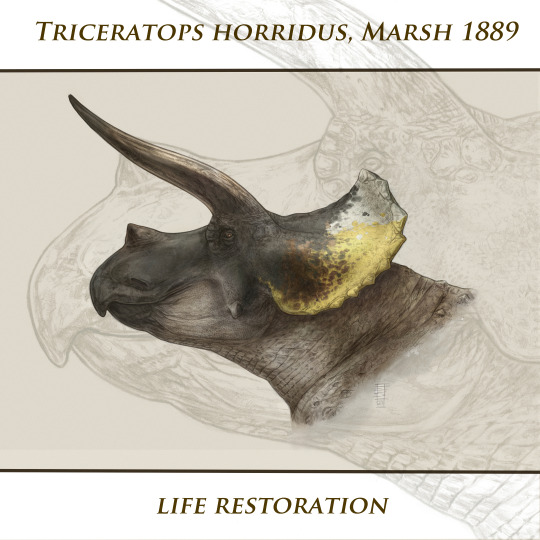
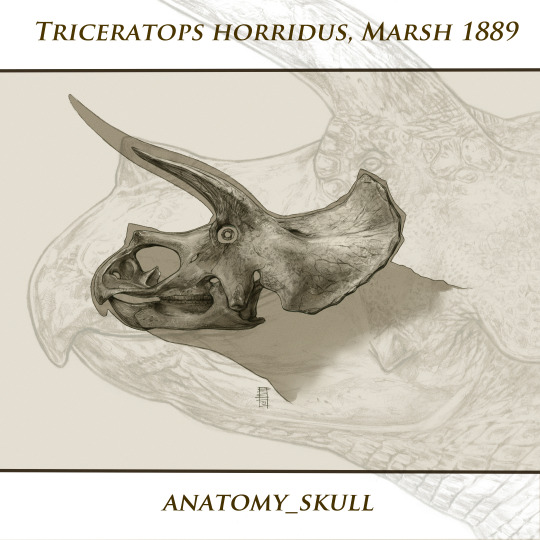
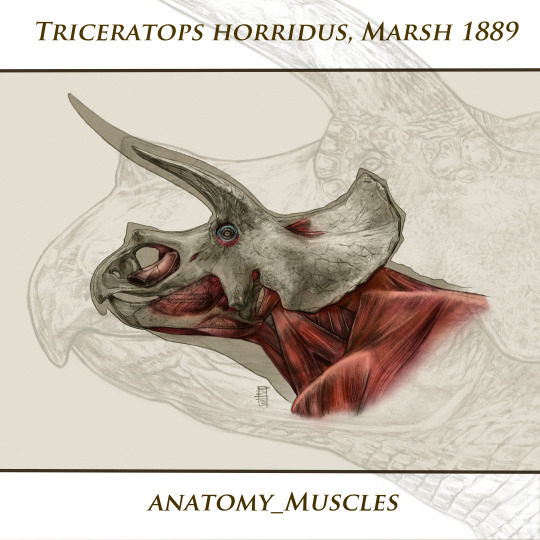

Study of a Three-Horned Face_Triceratops Sheet.
Pencils (2021) and digital (2024).
References
Matt Dempsey.
Prieto-Marquez, A. & Wagner, Jonathan. (2014). Soft-tissue structures of the nasal vestibular region of Saurolophine Hadrosaurids (Dinosauria, Ornithopoda) revealed in a “mummified” specimen of edmontosaurus annectens.
-------------------------------------------------
ArtStation
DeviantArt
Instagram
#paleoart#dinosaur#ornithischian#ceratopsian#triceratops#anatomy#scientific illustration#pencils#digital
90 notes
·
View notes
Text
Hypsilophodon

Hypsilophodon is a basal neornithischian dinosaur from the Early Cretaceous period of England. It has traditionally been considered an early member of the group Ornithopoda, but recent research has put this into question. It was a small, agile bipedal animal with an herbivorous or possibly omnivorous diet, measuring up to 2 m long and weighing 20 kg. It had a pointed head equipped with a sharp beak used to bite off plant material, as well as five pointed triangular teeth in the front of the upper jaw.
61 notes
·
View notes
Text
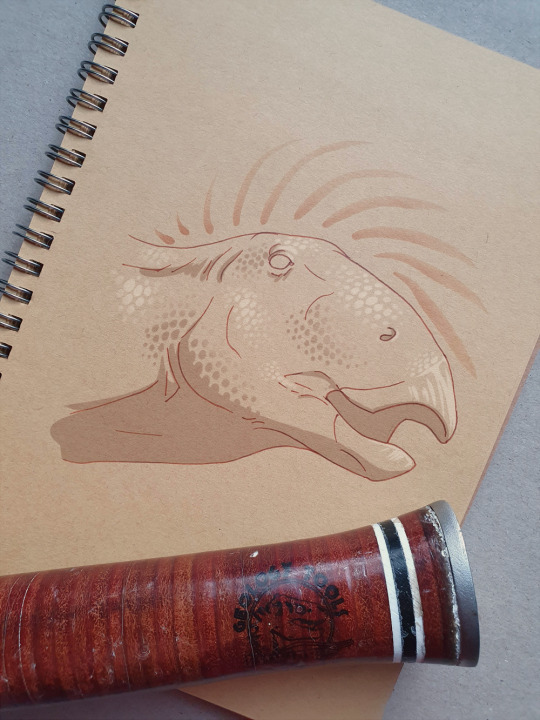
Day 16: Shantungosaurus giganteus
#paleoart#art#dinosaur#prehistoric#paleontology#digitalart#traditionalart#Archosaur#Archovember2023#Archovember#Dinovember#Dinovember2023#DrawDinovember#DrawDinovember2023#Shantungosaurus#Shantungosaurusgiganteus#hadrosaur#Ornithopoda#paleoblr#palaeoblr#digital art
32 notes
·
View notes
Text
Despite some minor delays, it's time once again for #Spectember – when I dive back into the big pile of speculative evolution concepts that you all submitted to me in 2020, and try to get through a few more of the backlog.
(…There's still over 50 of them left. This is going to take a while.)
So today's concept comes from an anonymous submitter, who requested an arboreal ornithopod dinosaur:
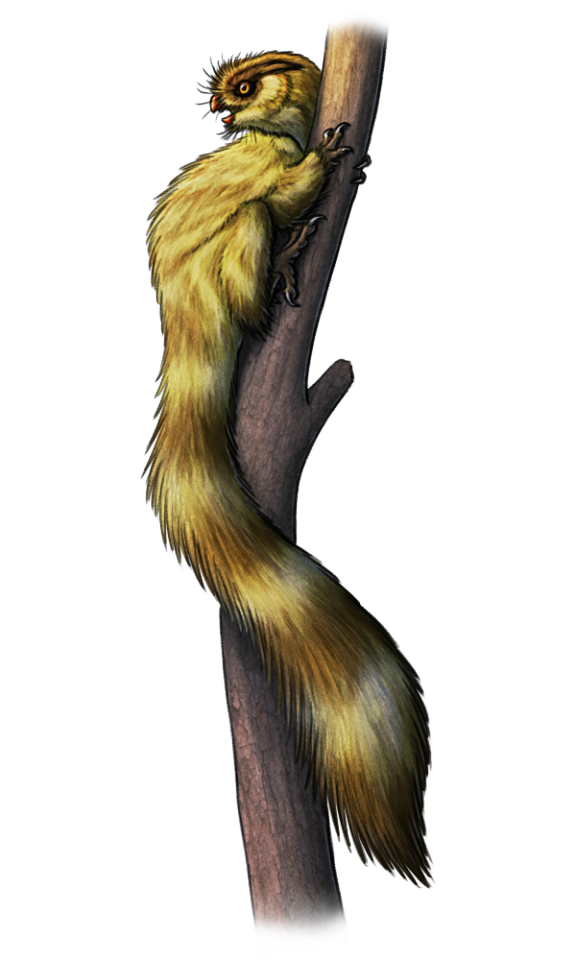
Anevasmasaura polaris is a small tree-climbing ornithopod that inhabits the temperate southern polar forests of the Early Cretaceous, descended from a Leaellynasaura-like ancestor. About 1m long (~3'3"), with over half that being just its long tail, it has a lifestyle similar to modern squirrels and lemurs – spending most of its time leaping around high up in the branches and only rarely venturing down to ground level.
It has zygodactyl feet, with the first and fourth toes reversed, and sharp curved claws that help it climb and grasp onto vertical tree trunks. Its face is short-snouted and superficially owl-like, with large forward-facing eyes that give it both depth perception and good night vision during the long dark polar winters.
Its diet is primarily herbivorous, using its short pointed beak to feed on the fruits and seeds of plants like cycads, ginkgoes, and conifiers, but it will also opportunistically eat invertebrates, eggs, and smaller vertebrates.
———
Nix Illustration | Tumblr | Twitter | Patreon
#spectember#spectember 2022#speculative evolution#ornithopoda#ornithischia#dinosaur#paleoart#science illustration#art
384 notes
·
View notes
Text
Tietasaura derbyiana Bandeira et al., 2024 (new genus and species)

(Type femur [thigh bone] of Tietasaura derbyiana [scale bar = 100 mm], from Bandeira et al., 2024)
Meaning of name: Tietasaura = [nickname for Antonieta, the main character of the novel Tieta do Agreste by Jorge Amado; the name Antonieta also means "priceless", referring to the value of the specimen] Tieta's lizard [in Greek]; derbyiana = for Orville A. Derby [founder and first director of the Brazilian Mineralogical and Geological Commission and former director of the National Museum of Rio de Janeiro]
Age: Early Cretaceous (Valanginian–Hauterivian)
Where found: Marfim Formation, Bahia, Brazil
How much is known: A partial left femur (thigh bone).
Notes: Tietasaura was an ornithopod, a group of plant-eating dinosaurs that includes the duck-billed hadrosaurids. However, it was only distantly related to the hadrosaurids, instead being a member of Elasmaria, a diverse group of small to medium-sized ornithopods from the Southern Hemisphere. Tietasaura is the first ornithischian ("bird-hipped") dinosaur to be named from Brazil.
The type specimen of Tietasaura was collected in 1906, but remained scientifically undescribed until now. It was originally labeled as a specimen of Hyposaurus, a seagoing, crocodile-like fossil reptile, and has only been recognized as a dinosaur following more detailed study.
Reference: Bandeira, K.L.N., B.A. Navarro, R.V. Pêgas, N.S. Brilhante, A.S. Brum, L.G. de Souza, R.C. da Silva, and V. Gallo. 2024. A reassessment of the historical fossil findings from Bahia State (Northeast Brazil) reveals a diversified dinosaur fauna in the Lower Cretaceous of South America. Historical Biology advance online publication. doi: 10.1080/08912963.2024.2318406
48 notes
·
View notes
Text

Day 7: Charonosaurus
A last of the parasaurolophini tribes of the Asian region.
#my art#dinosaur#paleoart#myart#dinosaurs#dinosauria#my drawings#charonosaurus#parasaurolophini#Hadrosauridae#lambeosaurinae#ornithopoda#ornithischia#sketchbookapp#sketchbook app#artists on tumblr
7 notes
·
View notes
Text
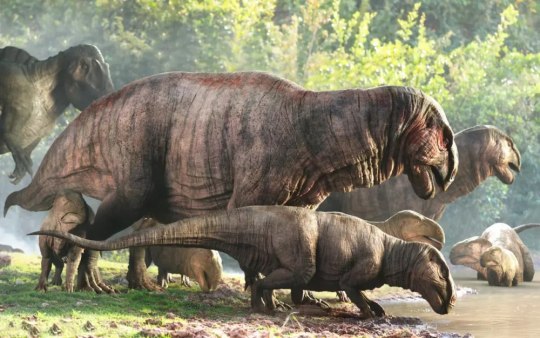
Iguanacolossus
Iguanacolossus — рід ігуанодонтових орнітоподових динозаврів, що мешкали в Північній Америці в ранньому крейдяному періоді.
Повний текст на сайті "Вимерлий світ":
https://extinctworld.in.ua/iguanacolossus/
#iguanacolossus#dinosaur#ornithopoda#dinosaurs#cretaceous period#art#cretaceous#north america#iguanodontia#paleontology#paleoart#prehistoric#animals#палеоарт#палеонтологія#ukraine#ukrainian#image#daily#ua#illustration#extinct#fossils#digital art#українська мова#динозавр#тварини#мова#україна
5 notes
·
View notes